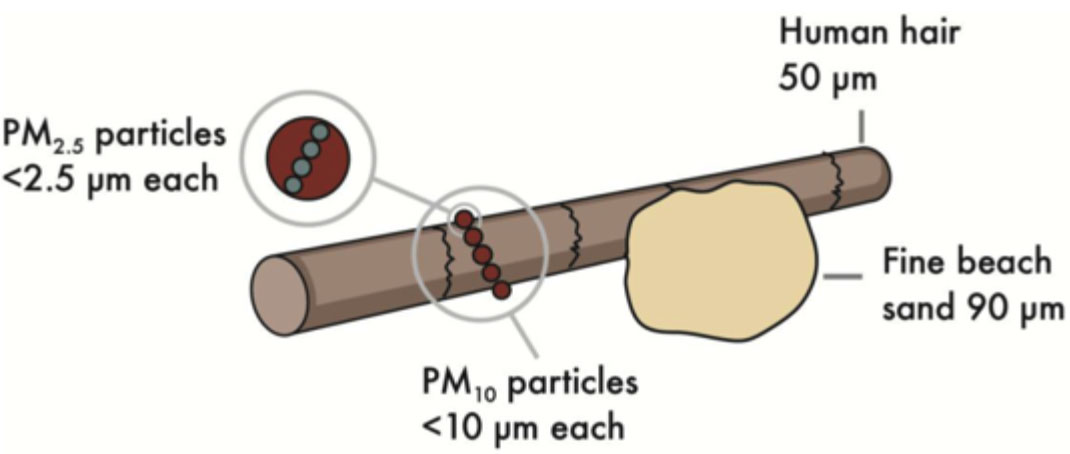About air quality and health
This section provides background information about air quality, and how it affects our health.
On this page:
Why is air quality important for health?
Good air quality is fundamental to our health and wellbeing. We each breathe about 14,000 litres of air each day. Contaminants in outdoor air can adversely affect our health.
Particulate matter in the air can contribute to heart (cardiovascular) and lung (respiratory) diseases, leading to hospital admissions and premature death. Outdoor air pollution can also cause cancer [1].
People more at risk from poor air quality include:
- young children
- older adults
- people with chronic health conditions, particularly cardiovascular or respiratory disease.
What is air pollution?
Air pollution is a complex mix of tiny particles and gases, including:
- particulate matter (such as PM10 and PM2.5)
- carbon monoxide
- nitrogen oxides
- sulphur oxides
- volatile organic compounds.
What is particulate matter (PM)?
The most significant impacts on human health from air pollution are due to exposure to PM. PM consists of small airborne particles, including solid matter and liquid droplets. PM can affect more people than any other pollutant, so the relationship between health impacts and PM air pollution is therefore well researched [1].
PM2.5 refers to particles with a diameter of less than 2.5 micrometres (Figure 1). These particles are mainly produced by the combustion of fossil fuels (e.g., motor vehicle emissions, burning wood and coal for home heating) and through the transformation of other particles such as NOx, SO2, and organics.
PM10 refers to particles with a diameter of less than 10 micrometres, which is the major air pollutant monitored in New Zealand (Figure 1). These particles are derived primarily through suspension of dust and soil and other materials from roads, farming, construction, mining activities, and coal and oil combustion. PM10 also includes sea salts, mould, pollen and other plant parts [1, 2].
Figure 1: Relative size of particulate matter
Source: Ministry for the Environment [3]
Health effects of air pollution
Air pollution can affect people’s health, especially their heart and lungs – and can even lead to early death. About half of the health impacts from air pollution in New Zealand are associated with particulate matter [4]. Some people are more at risk of poor health due to air pollution. Population groups most affected by air pollution include: children, especially those with asthma; older adults; people with pre-existing health conditions, particularly respiratory and heart conditions, and diabetes.
Particulate matter (PM10 and PM2.5):
Coarse particles such as PM10 deposit in the upper airways, whereas small particles such as PM2.5 deposit in the very small airways deep in the lungs [2].
Short-term and long-term exposure to PM10 and PM2.5 is associated with a wide range of health impacts. Mild impacts include shortness of breath or coughing. More severe impacts include premature death from cardiovascular and respiratory problems and an increased risk of lung cancer. Exposure to PM10 can also worsen asthma symptoms. Exposure to PM2.5 is associated with asthma, diabetes and adverse birth outcomes such as low birth weight, preterm birth and small-for-gestational-age births [1,3].
Children, the elderly, and people with pre-existing conditions such as cardiovascular or respiratory diseases are particularly vulnerable to health impacts from PM air pollution [3].
Natural and human sources of air pollution
Air pollution can be produced from human activity or naturally. The main sources of air pollution in New Zealand are:
- wood and coal fires (for home heating)
- motor vehicles
- industry
- open burning
- natural sources.
Wood and coal fires produce particulate matter, carbon monoxide, nitrogen dioxide and other organic compounds. Read the latest statistics about wood and coal fires on the wood and coal fires webpage.
Motor vehicles produce a range of gases and particles, including particulate matter, carbon monoxide, nitrogen dioxide and sulphur dioxide. Air pollution from vehicles comes from vehicle exhaust and brake and tyre wear. Diesel vehicles, older, and poorly maintained cars tend to produce more emissions. Read the latest statistics on the motor vehicles webpage.
Industrial sources of air pollution include major facilities like steel mills, chemical plants and coal-fired power plants. The most common pollutants from manufacturing, construction and electricity production activities are sulphur dioxide, PM10 and NOx [3].
Open burning (or outdoor burning) refers to burning combustible material outdoors. These materials can include household rubbish, garden clippings and agricultural waste.
Natural sources of air pollution include windblown dust, pollen, volcanic ash and sea spray.
Another impact of fires, vehicle emissions and industrial sources is the release of greenhouse gases (mainly carbon dioxide). Greenhouse gases contribute to climate change. Read more on the climate change webpage.
Weather conditions and topography affect air quality
Weather and topography can influence air pollution. Air pollution levels tend to be worse during winter, particularly on cold calm days. Weather conditions can affect the quantity, patterns and dispersal trends of air pollutants [3].
- On cold days, households may burn more wood and coal for home heating. Vehicles may also release more emissions due to ‘cold starts’.
- Low wind speeds can prevent pollutants from dispersing.
- Low wind speeds and cold temperatures can cause temperature inversions. These are where a cold layer of air is trapped by a warmer layer of air above, trapping air pollution near to the ground. Temperature inversions are more likely to occur in valley locations.
- Most urban air pollution occurs in winter and is worst during cold calm conditions.
- In some cases (usually in warmer months), strong winds can lead to higher PM₁₀ levels by raising dust – particularly during droughts.
Guidelines and standards for air quality in New Zealand
National Environmental Standards for Air Quality (NESAQ) for air pollutants [3] and WHO guidelines [1] have been developed to provide some level of protection against health risks.
Table 1: National Environmental Standard for Air Quality (NESAQ) and WHO guidelines for PM10, PM2.5, NO2, SO2, CO, and O3
|
Air pollutant |
National Environmental Standard for Air Quality (NESAQ) |
WHO guideline (2021) |
|||
|
Threshold (µg/m3) |
time period |
Allowed number of exceedances |
Threshold (µg/m3) |
Time period |
|
|
PM10 |
50 |
24-hour |
1 in a 12-month period |
50 |
24-hour |
|
15 |
annual |
||||
|
PM2.5 |
na |
na |
na |
15 |
24-hour |
|
5 |
annual |
||||
|
NO2 |
200 |
1-hour |
9 in a 12-month period |
10 |
annual |
|
25 |
24-hour |
||||
|
SO2 |
350 |
1-hour |
9 in a 12 month period |
40 |
24-hour |
|
570 |
1-hour |
None |
|||
|
CO |
10 |
8-hour |
1 in a 12 month period |
4 |
24-hour |
|
O3 |
150 |
1-hour |
na |
60 |
8-hour |
Source: Ministry for the Environment and Stats NZ 2018 [3]
For more information, visit the Ministry for the Environment’s National Environmental Standards for Air quality webpage.
Monitoring air quality in New Zealand
Air quality is measured at monitoring stations throughout New Zealand. Air quality data is collected by regional councils and unitary authorities, and reported to the Ministry for the Environment.
Air quality may vary from year to year, depending on weather conditions. Colder winters may lead to households burning more wood and coal for home heating, and higher levels of air pollution. Statistical analysis of several years of data is needed to determine long-term trends in air quality in an airshed.
The latest study of the health impacts of air pollution, HAPINZ 3.0, was released in 2022. This study found that there were more than 3,300 deaths from human-made air pollution in New Zealand in 2016. You can explore the results of the HAPINZ 3.0 study on the HAPINZ 3.0 webpages.

